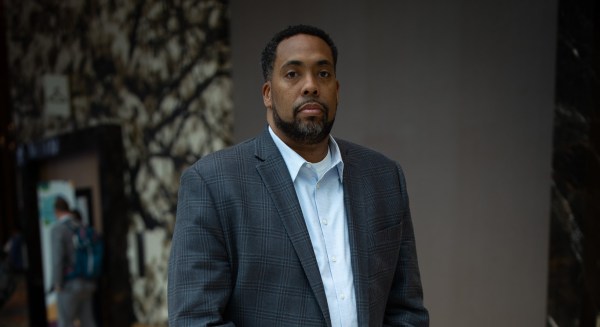Massive modernization: Delaware CIO highlights lessons learned

States are often saddled with outdated hardware and laundry lists of languishing applications, yet Delaware Chief Information Officer James Collins is leading his state to embrace the latest cloud technology while cutting costs at the same time.
At the National Association of State Chief Information Officers midyear conference on Monday, Collins spoke to StateScoop about Delaware’s endeavor to modernize its databases through Cisco and other cloud offerings and how the state saved more than 36 percent on its IT infrastructure costs. In his remarks, Collins dove into the nuances of securing funding for modernization, common pitfalls and misconceptions about legacy upgrades, and where Delaware would like to go next as it swaps out its old hardware.
Now the state is working on what would become the nation’s first cloud-based system for child-welfare case workers.
Collins said the work is all about improving application efficiency and deployment speeds, but is largely driven by a need to meet today’s rapidly changing demands for services that are easily accessible and adaptable to different devices and systems.
StateScoop: What factors have led to Delaware’s modernization efforts?
Delaware CIO James Collins: I think that technology has really changed the way government delivers services, but government is still changing from what I call this siloed manila-folder approach to the information age. So we have all of these silos across government’s branches, agencies and divisions. And that siloed approach has made government build all these data centers and infrastructure that is scattered across the state. This was probably fine when we didn’t have the cyberthreats we have today and when there was a tolerance for outages and things like that. Today there is no tolerance for any downtime. There are exponentially more systems across the state delivering services to citizens and supporting state employees as they try to deliver services. So we have to abandon these silos and move towards a more enterprise approach. We need infrastructure that is scalable, reliable, secure and can be rapidly deployed. Those are the things that are really pushing us in the direction that were going.
What systems were replaced?
Collins: We’re in this process of centralization in Delaware where we’re creating the enterprise approach to IT and there were, I want to say, around 15 different places in the state where we were housing data. Now we’re down to about six, so we’ve been taking a lot of that infrastructure and virtualizing it — moving from individual services to virtual servers — and we’ve been doing quite a bit with Cisco’s Unified Computing System (UCS). And I’ll tell you what, it has been a game changer for our environment. We’ve been able to deploy [apps, platforms and digital tools] 10 times faster than we did before with a 36 percent savings in what we would normally spend on infrastructure.
When we started to use the UCS platform, we were going from individual servers in some instances, like when we centralized the Delaware Department of Transportation. They had a datacenter that had some virtualization but many individual servers as well. We moved them from that old infrastructure to the new UCS platform and even some of their legacy applications [using the UCS] saw a marked increase in efficiency and responsiveness. We also moved the state portal and heard feedback from the Government Information Center that maintains it, reporting significant performance gains in the website.
And you know Delaware is the corporate capital of the world, [corporations legally headquartering in the state take advantage of its low taxes and less restrictive regulations] and so when they have tax time it beats on our systems, so we modernized this system to a new application with the UCS infrastructure and they set records in the amount of time they could process payments. The speed was like never before.
One of the great struggles in state government is trying to free up funding from legacy system maintenance to invest in modern technology. How were you able to generate the funding needed and justify the expense?
There’s definitely a shift going on. There used to be these capital expenditures and bond money focused on buying in-house hardware and enterprise class infrastructure and now we have this shift to new technologies where we’re incorporating our private cloud, where we’re incorporating commercial cloud software as a service (SaaS) and that definitely is a change from how we did things in the past. We have absolutely had to bring along fiscal folks into the purchasing process, and especially with SaaS, because they’re used to these large, long-term purchases and then 20 percent maintenance year after year. Now that large purchase goes away and there is just this flat [software subscription] cost, so we have to educate them on that. But circling back to the beginning of your question, when you think about the 36 percent savings on some of the infrastructure purchases, now we can actually redirect some of those resources into things that are really customer-facing. From my perspective, customers and employees want to be able to access our systems and services anywhere, anytime and from any devices and so that is a little bit of a change for us. So we’ve had to redirect some of those resources to deploy mobile, responsive applications. So this modernization is absolutely necessary to deal with anywhere, anytime and any device demands of today.
StateScoop: What advice, strategies or suggestions would you give to city and state CIOs looking to do the same kind of modernization?
Collins: What we are talking about is a major paradigm shift and the demand today for enterprise technology today is just too great to continue to do business as usual. So one of things we have to get our mind around as IT agencies is morphing into what might be considered a broker of services. We don’t have to build everything, we don’t have to provide every service. There are many partners out there in the market that are providing best of breed solutions and one of the ways for us to rapidly deploy things is to incorporate those partners into our service offerings. That’s a big change, and a big change for the staff. When you bring in these cloud technologies and you have staff that have been taking care of [older] infrastructure for a lot of years, you’ve got to be careful to communicate in how they fit into the new normal that an agency is facing. That is something I would encourage my colleagues to focus on.
StateScoop: What’s a common misconception or factor that most CIOs and technologists might not consider when replacing old legacy hardware and software?
Collins: I think the most common one that we encounter is that agencies have used systems for 5, 10, 15, sometimes 20 years, and sometimes when it’s time to do the modernization work they focus on rebuilding what they’ve been using into the new system. And if you do that, there is a danger in not leveraging the new technology to be more efficient. It’s not just about replicating what we had before, but it’s really about fleshing out your requirements and then applying that to the new technology to enable you to do things exponentially faster. We constantly run into people wanting to recreate the old system, and we have to say, “No, we’re creating a new system for a reason, we’re modernizing for a reason.” That’s one of the key challenges with this modernization work — to bring the agency up to speed on the new technologies that are available and how that can impact their work. I’ve seen agencies take a “best of breed” product and make it less efficient by trying to make what they had before instead of taking advantage of modern practices. This costs you money, too, down the road for maintenance and upgrades.
StateScoop: What are next big systems you’d like to modernize in Delaware and are there any other plans in the works to modernize systems in the near future?
Collins: We just did a major upgrade to our eligibility systems for Health and Social Services and the Medicaid Systems in Delaware. We’re also working on our child welfare system right now and it’s the first cloud-based child welfare system in the nation, so a lot of eyes are on that. It’s a pretty big initiative and we’re taking a different approach here, we’re using a [cloud] platform to develop it with and it’s allowing rapid deployment. It’s roughly a 17 to 18 month project as opposed to a project that takes three or four years. The cost is significantly less and it’s modern technology. The cloud platform makes it inherently mobile responsive so your employees will be able to do their work wherever they are and have case information in the field. We’re also modernizing our business one-stop portal, which allows entrepreneurs to start a business and companies to pay taxes and perform other transactions all from a single portal. It’s interfacing with systems in the Department of Labor, the Department of Revenue and others so businesses have a unified view of all of those relationships in one portal.
My dream is to do the citizen portal next, but we’re doing the business portal first so we can be consistent with Gov. John Carney’s priority of economic development and business creation in Delaware.
This interview was edited lightly for readability.






